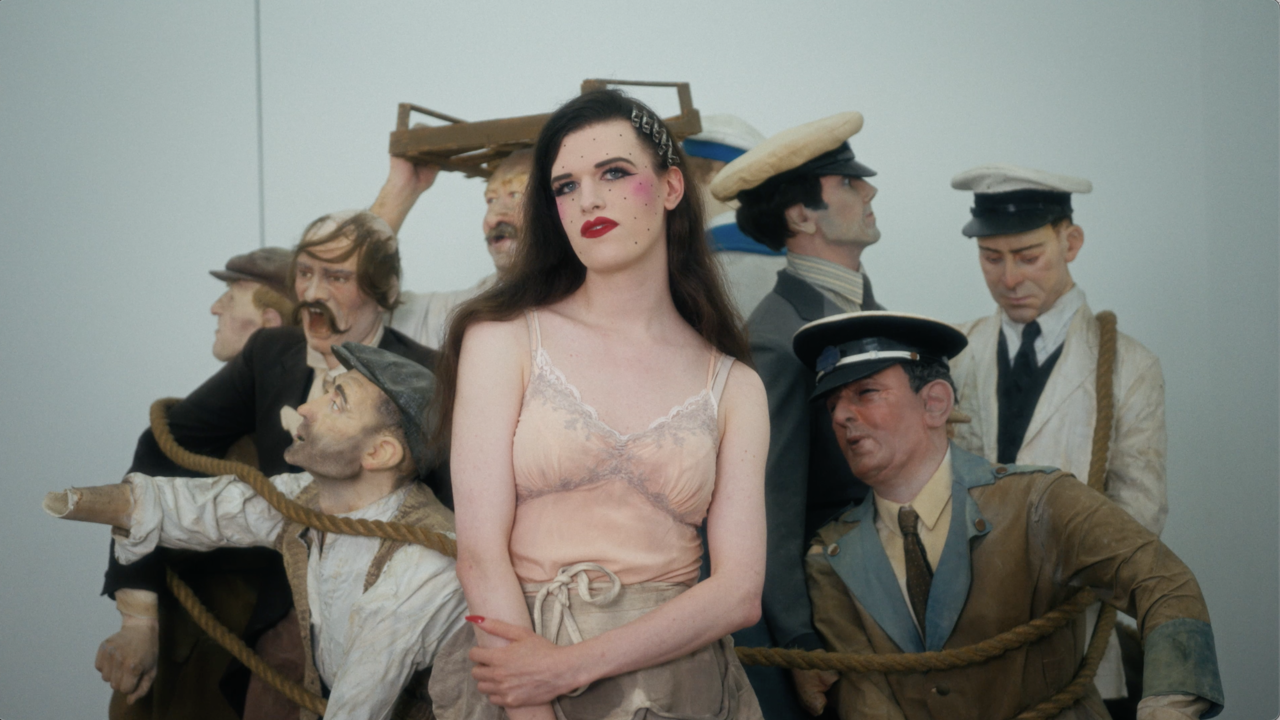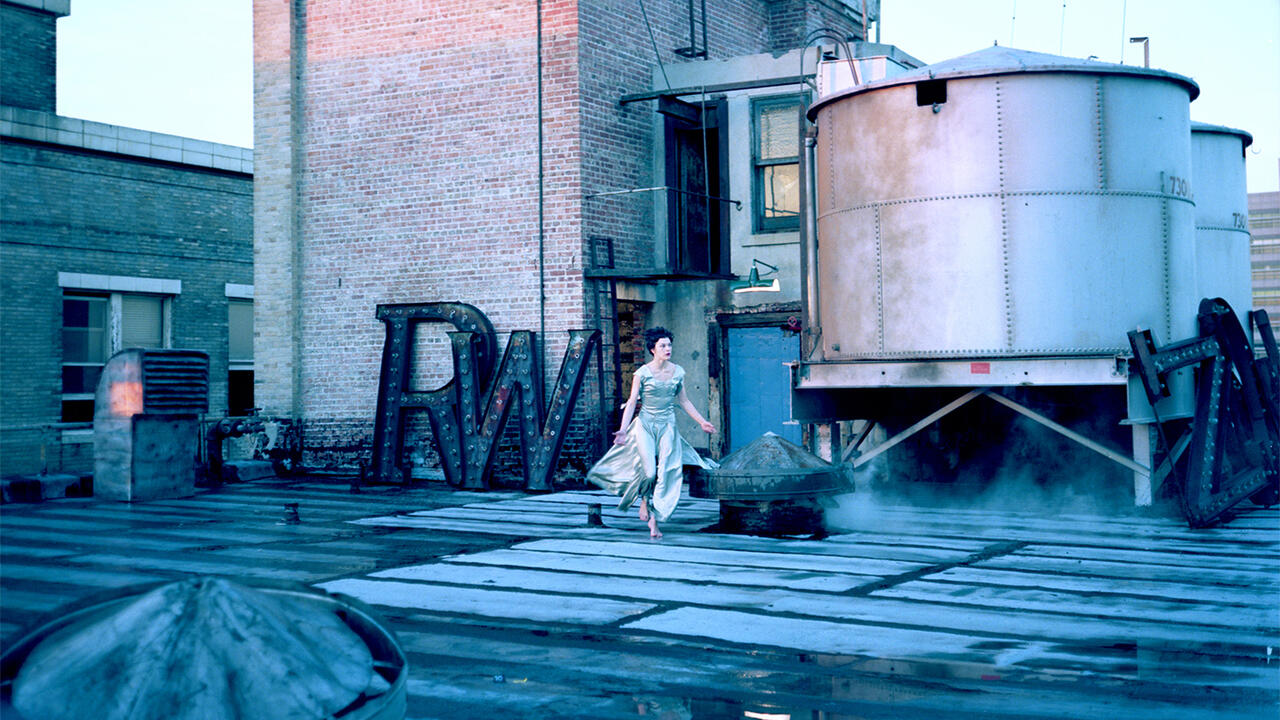In Focus: Loretta Fahrenholz
Films crafted from complexity, complicity and contradiction
Films crafted from complexity, complicity and contradiction

Loretta Fahrenholz’s 2013 film Ditch Plains opens with a dystopian scene of inert bodies lying on deserted city streets at night. Shot in the aftermath of Hurricane Sandy, the film follows the protagonists – members of Ringmasters Crew, a New York-based dance group – as they roam through scenes of devastation in the city’s outer boroughs, while locals line up to fill their plastic cans at the gas station. Their jittering, fragmented movements (the dancers are virtuosos of Flexing, a street style involving acrobatic contortions), sharply edited to a jagged soundtrack, seem to turn the derelict front porches and deserted nighttime streets into a video-game backdrop. ‘People don’t know how to act,’ says the digitally manipulated voice of an unseen narrator. ‘Just lie down. Lie down and quit acting like you know.’ Lit by Day-Glo strips, the dancers move as if possessed, but the film’s compelling urgency is rather born of dispossession: the question of how to act in a disaster zone, or in a life punctuated by stop and search, interrogation and vigilation, when actions themselves are out of your hands.
Fahrenholz has made half a dozen films since graduating from the Academy of Visual Arts in Leipzig in 2007. The question of how to act filters through her films, as they suggest the power structures, economic necessities and social pressures that come to determine actions and define roles in daily life. This is perhaps most explicit in Implosion (2011), based on Kathy Acker’s 1983 play of the same name, a French revolutionary tale transposed to a 1980s Manhattan full of heroin, bankruptcy and sex. In Fahrenholz’s interpretation of the play, all of the characters – My Father, My Grandmother, Danton, Robespierre, Schoolmistress – are played by young gay men, their character names spelled out in subtitles. This skewing of gender relations, along with the actors’ unflinchingly monotonous intonation, suggests a disaffected inhabitation of the script, rather than a full-blooded performance – more re-enacting than acting. The actors’ behavioural slickness is reflected in the glossy interiors of the downtown Manhattan hotel in which the film was shot: all plate-glass windows and venetian blinds, accessorized with elaborate flower arrangements, MacBooks and iPhones. Oblique conversations and vapid sex scenes are performed with such detachment that the narration seems to consist only of gaps and slippages – between roles and characters, genders and sexual relations, meaning and actions, or the raw Manhattan landscape of Acker’s 1980s and the monied, networked veneer of the early 2010s.

It is the question of complicity that makes Fahrenholz’s films so hard to pin down, however. How familiar is she with this sexually ambivalent posse of New York hipsters, or with the flexing dancers from the Ringmasters Crew? Fahrenholz describes her process as essentially reactive and observational; her aim is to get so close to her subject matter through preliminary discussions and collaborative script-writing that she disappears into it. Thus the films themselves seem to mirror the situations or people they portray, with Fahrenholz acting as an invisible conduit. Despite the fictional narratives of Ditch Plains and Implosion, the artist sees her work in terms of documentary filmmaking, and to read it as such proves instructive. She names renowned documentary filmmaker Frederick Wiseman as an influence: in the 40 films he has made to date, Wiseman rejects reflexive or expository elements such as interviews or narration, preferring to let the filmed actions speak for themselves. His is an immersive filmmaking process, whereby hundreds of hours of footage are sifted through and shaped into a dramatic structure. Wiseman sees his films as stemming from his own personal experience of each situation, as does Fahrenholz, who describes her recent work as arising from observations made since she moved to New York four years ago.

Although the initial impetus is personal, the material in Fahrenholz’s films develops through discussions between herself and her actors – a horizontal rather than hierarchical way of directing. Likewise, text is treated as just another layer of material, rather than as the prime conveyor of meaning. The spoken dialogue in Implosion, for instance, behaves as a distinct element within the film that does not necessarily coalesce with either action or setting. This incongruence between words and action represents just one of the many lacunae that arise and are implicit in such a collaborative process.
Fahrenholz calls her films ‘performative documentaries’, suggesting not only hybrid forms but also highlighting the performed nature of daily life. For the artist, the slick glossiness of Implosion came about as a direct stylistic counterpoint to the gritty faux realism of her previous film, Haust (2010), which she made in Leipzig after finishing her studies there. Haust follows the fortunes of three friends and a newcomer to their shared house as they try to make sense of, and get by in, the vague territory of post-graduate life. Frequent close-ups of the faces of the young protagonists suggest a complicity with the director so tight that it is hard to know whether this is performance or documentary. This is intensified by the fact that Fahrenholz herself was a recent postgraduate at the time, living in the house in which the film is staged, together with her friends who play versions of themselves in it. It is impossible to determine which role is assumed, which words are scripted, what is performed naturally and what is acted. The dilemma here is not that they ‘don’t know how to act’, but rather that they know all too well.

The internal complexities and contradictions in Fahrenholz’s films can make them appear opaque at first, but it becomes apparent on repeated viewing that complexity and contradiction form their very fabric. The artist pictures this through subtle interventions – of sound, costume, location – but draws it out, like Wiseman, through the time-consuming process of editing. Throughout the different genres Fahrenholz’s quixotic films inhabit – from the sci-fi landscape of Ditch Plains, to the dun-toned realism of Haust or the slick alienation of Implosion – complexity is shown to be the most valid response to reality. We are all bound to it, as the voice in Ditch Plains states: ‘No one escapes. Not even me. This is not The Matrix.’
Loretta Fahrenholz is an artist living in Berlin, Germany. In 2013, she had solo shows at Ludlow 38 and Reena Spaulings Fine Art, both in New York, USA, and at Galerie Buchholz, Berlin. She is currently artist in residence at Villa Romana, Florence, Italy.






















